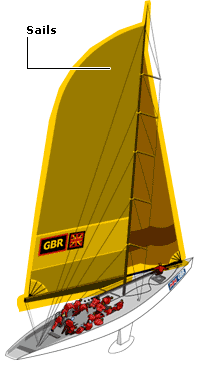|
|
|
There are three main
types of sail used on an America's Cup boat. Mainsail: Around
220 metres square, flown behind the mast and secured to the
boom. Battens are set in
pockets parallel to the boom to keep the trailing edge of
the sail (leech) taut. Mains are typically made
of carbon and Kevlar and weigh 95kgs, costing a basic
£80,000 before customising. Each team is allowed 45
sails for the Louis Vuitton Cup, with an extra 15 permitted
for the America's Cup proper. A syndicate is likely to
hold about nine mainsails for different conditions but would
only carry one during a race. A mainsail wears out easily
and one main might last one round robin (eight races).
Headsail (Jib):
An upwind sail that is flown before the mast, costing around
$120,000. Five headsails, of different size and weight, will
be carried in one race and selected according to conditions.
The biggest headsail is
called a genoa, which overlaps the mast. A genoa may measure
up to 130 meters square. Headsails are moulded
from one piece of carbon/Kevlar composite laminated onto a
mylar mould. A genoa weighs about
48kg. It takes two people to lift the sail around on deck or
three to drag it up from down below. Spinnaker: The
huge, colourful billowing sail flown at the front when
sailing downwind. Spinnakers can either be
symmetrical, and flown from the top of the mast in lighter
winds, or asymmetrical, when they are flown lower and used
for lighter winds and closer wind angles. The spinnaker is
attached to a spinnaker pole, which is used to project the
sail at the optimum angle to the wind. The pole is a carbon
spar which measures about 11m and weighs about 40kg. It is
controlled by a guy (rope) which is fed back to the winches.
Spinnakers are made of a
complicated form of nylon and measure up to 500 metres
square. Five different
spinnakers &endash; three asymmetric, two symmetric - will
be carried during a race and used depending on
conditions.


![]()